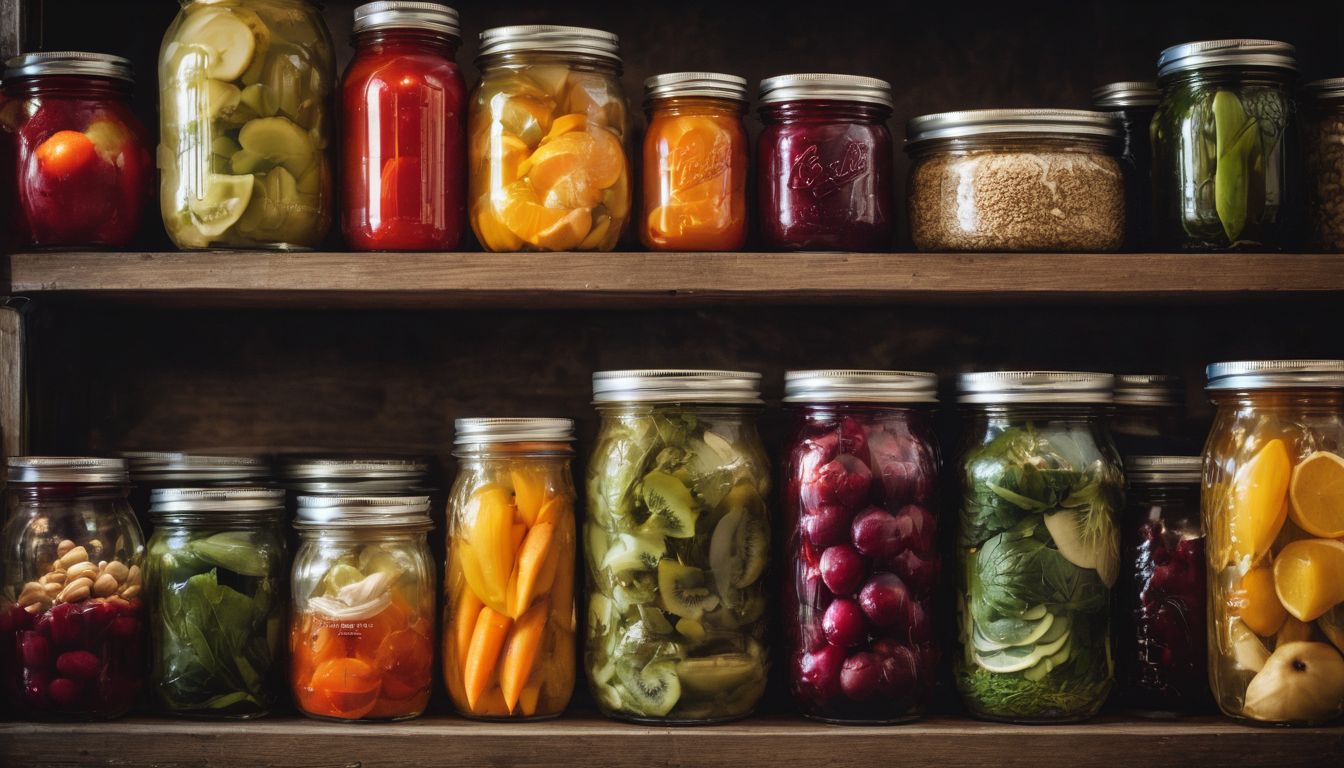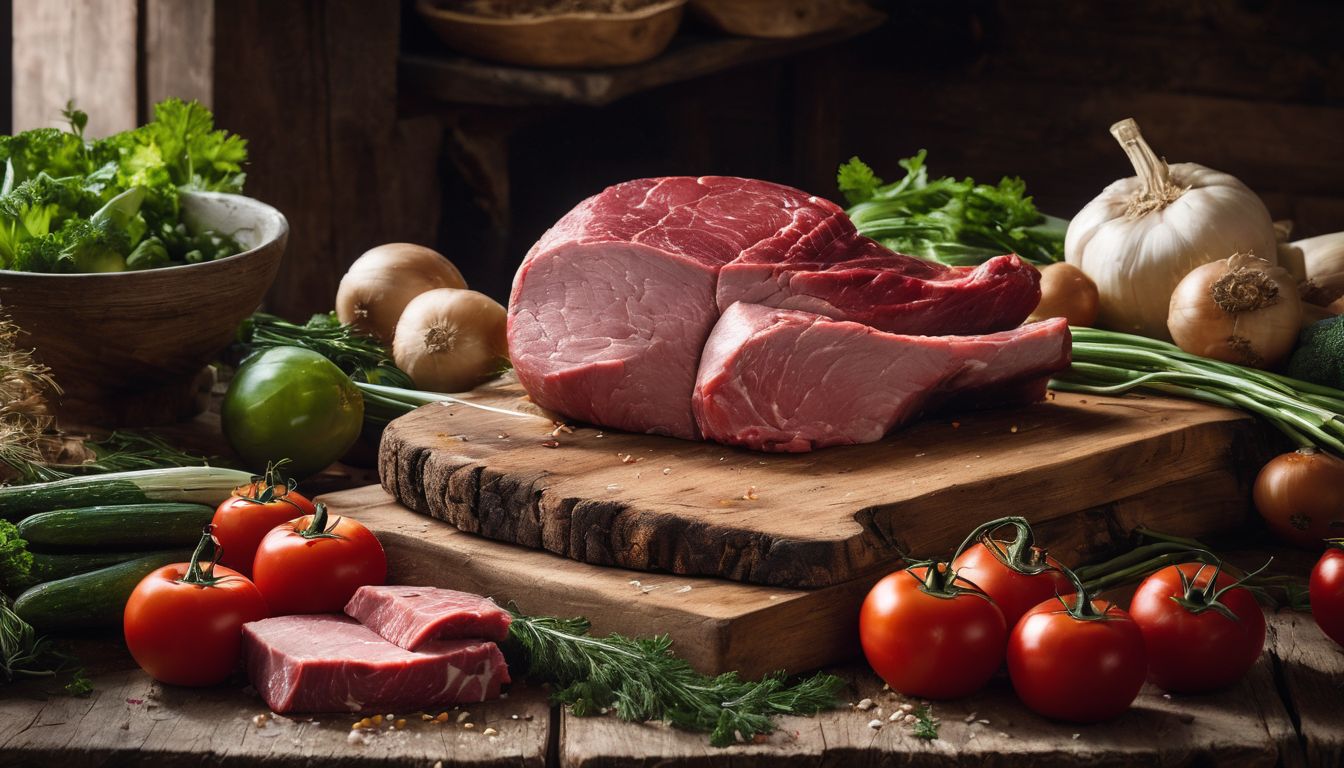Struggling to eat healthier at home? Fermentation might be the secret you’re missing out on. This age-old technique transforms ordinary foods into probiotic-packed powerhouses, enhancing both flavour and nutrition.
Dive in with us to unlock this culinary treasure trove!
Key Takeaways
- Home fermentation transforms foods into nutrient-rich, probiotic-packed delights that support gut health and boost immunity.
- Different types of fermentation include vegetable, dairy, and beverage fermentations, each with its own specific benefits and methods.
- Key factors for successful home fermentation are maintaining the right temperature, ensuring cleanliness to avoid contamination, and using high-quality ingredients.
- Experimentation with various vegetables, herbs, spices or fruits can lead to unique flavour combinations in fermented foods.
- After fermenting foods at home, store them correctly to prolong shelf life while still receiving their health benefits.
Understanding Fermentation
Fermentation is the process of using yeast or bacteria to convert sugars into alcohol, acids, or gases. There are different types of fermentation, each with its own unique benefits and uses.
What is fermentation?
Fermentation turns simple ingredients into probiotic-packed foods through the action of bacteria and yeast. This ancient technique preserves organic produce while enhancing flavour and nutritional value.
At its core, fermentation relies on microorganisms to convert sugars in food into alcohol or acids under anaerobic conditions, meaning without oxygen.
In this natural process, beneficial bacteria such as lactobacillus start breaking down compounds like glucose to release energy. The result is a transformation that gives us tangy sauerkraut from cabbage or a fizzy kick in kombucha tea.
Home fermentation taps into this eco-friendly tradition to create delicious, healthful treats right in your own kitchen with just vegetables, saltwater brine, and sometimes a bacterial starter or culture.
The fermentation process
During fermentation, microorganisms like bacteria and yeast break down sugars in foods and produce acids, gases, or alcohol. This process occurs in anaerobic conditions, meaning without the presence of oxygen.
Fermentation is used to make a variety of foods such as kimchi and sourdough bread. In the absence of air, lactic acid bacteria transform raw vegetables into pickles, unlocking their nutrients and creating a tangy flavour.
Similarly, yeast converts sugar into alcohol during beverage fermentation.
This natural preservation method not only enhances the nutritional value of food but also creates probiotic-packed foods that support gut health. The fermentation process not only prolongs the shelf life of perishable items but also reduces food waste by utilising surplus produce that might otherwise go bad.
Types of fermentation
After understanding the fermentation process, it’s important to explore the different types of fermentation. Here are the main types to consider:
- Lactic Acid Fermentation: This type occurs when sugars are converted into lactic acid by bacteria. It’s commonly used in the production of yoghurt, kefir, and some cheeses.
- Alcohol Fermentation: This process involves the conversion of sugars into alcohol and carbon dioxide by yeast or other microorganisms. It’s utilised in making beer, wine, and other alcoholic beverages.
- Acetic Acid Fermentation: This type results in the production of acetic acid by bacteria and is often seen in the creation of vinegar.
- Propionic Acid Fermentation: This process produces propionic acid and carbon dioxide by bacteria, commonly used in the production of Swiss cheese.
- Butyric Acid Fermentation: Here, butyric acid is produced from various substrates by bacteria, often involved in the fermentation of plant fibres.
- Enzyme Fermentation: In this type, enzymes facilitate the breakdown of materials such as starches or cellulose into simpler compounds for further fermentation processes.
Benefits of Fermentation
Fermentation offers a range of benefits, from improving gut health and aiding digestion to boosting immunity and helping with nutrient absorption. Whether it’s through vegetable fermentation or dairy fermentation, incorporating fermented foods into your diet can have a positive impact on your overall well-being.
Improves gut health
When consuming fermented foods, such as kimchi or sauerkraut, the probiotics introduced during fermentation support a healthy balance of bacteria in the gut. This process aids digestion and helps with nutrient absorption.
The active cultures in fermented foods also contribute to boosting immunity, promoting a healthier overall digestive system.
By regularly incorporating lactofermented foods into your diet, you can enjoy the benefits of improved gut health and better digestion while supporting conservation efforts through sustainable food practices.
Aids digestion
Fermented foods aid digestion. They contain beneficial enzymes and probiotics that support gut health. These elements help break down and absorb nutrients, improving overall digestion.
Incorporating fermented foods into your diet can contribute to a healthier digestive system.
Furthermore, the process of fermentation partially digests food for you, making it easier on your body to extract nutrients from these foods. This can enhance nutrient absorption and promote better overall health.
Boosts immunity
Improving gut health via fermentation encourages a balanced immune system. Fermentation introduces beneficial bacteria into the gut, supporting overall immunity. This process aids in the body’s defense against harmful pathogens and strengthens its ability to fight off infections, promoting overall health.
Fermented foods contribute essential nutrients that assist in maintaining a strong immune response. These probiotic-packed foods enhance the body’s natural defenses by fortifying it with vitamins and minerals critical for a robust immune system.
Regular consumption of fermented foods can help sustain a healthy balance of microorganisms within the gut, promoting wellbeing and resilience.
Helps nutrient absorption
Fermentation helps nutrient absorption by breaking down food components, making them easier for the body to assimilate. This process enhances the bioavailability of essential vitamins and minerals present in fermented foods like vegetables and dairy products, ensuring that your body can make the most of these vital nutrients.
Moreover, fermentation unlocks valuable enzymes and probiotics that support gut health, digestion, and overall immunity. By incorporating fermented foods into your diet, you actively contribute to a sustainable lifestyle while enjoying the benefits of improved nutrient absorption.
Different Types of Fermentation
Vegetable fermentation involves preserving vegetables in a brine solution, while dairy fermentation is used to make yogurt and cheese. Beverage fermentation can include making alcoholic beverages like beer and wine or non-alcoholic drinks like kombucha.
Vegetable fermentation
In vegetable fermentation, fresh produce is transformed into tangy, crunchy delights through the magic of lacto-fermentation. This process involves submerging vegetables in a saltwater brine to create an environment where beneficial bacteria can thrive and multiply.
These probiotic-packed foods not only have a long shelf life but are also rich in gut-friendly bacteria that support digestion and overall well-being. By fermenting your own veggies at home using quality ingredients and proper hygiene practices, you can enjoy the satisfaction of creating your own nutrient-rich pickles while reducing food waste.
The fermenting jars used for vegetable fermentation make the perfect DIY project for environmentally conscious individuals looking to reduce their carbon footprint by making their own fermented foods at home.
Dairy fermentation
Moving on from vegetable fermentation, let’s delve into the world of dairy fermentation. During this process, beneficial bacteria such as Lactobacillus and Bifidobacterium are introduced to milk or cream.
These bacteria convert lactose into lactic acid, giving dairy products their characteristic tangy flavor and creamy texture. Common examples of dairy fermentation include yogurt, kefir, buttermilk, and sour cream.
In addition to creating delicious treats for your taste buds, dairy fermentation also results in probiotic-packed foods that support gut health. By incorporating homemade fermented dairy products into your diet, you can actively contribute to improved digestion and overall well-being while reducing food waste at home.
Beverage fermentation
Transitioning from dairy fermentation to beverage fermentation, let’s explore the world of probiotic-packed drinks. Beverage fermentation involves the transformation of various liquids into refreshing and health-boosting beverages through natural processes.
Kombucha, kefir, and ginger beer are just a few examples of these delightful concoctions that offer a myriad of flavours and gut-friendly benefits. When experimenting with DIY fermentation at home, environmentally conscious individuals can enjoy the satisfaction of crafting their own probiotic-rich drinks while supporting conservation efforts by reducing reliance on store-bought alternatives.
By harnessing Japanese fermentation techniques or embracing traditional methods like home brewing, individuals can create unique and satisfying beverages that not only tantalise the taste buds but also promote environmental sustainability.
Tips for Successful Home Fermentation
– Maintain proper temperature to ensure the fermentation process is successful.
– Practice good hygiene to prevent contamination and spoilage of fermented foods.
Proper temperature
To successfully ferment foods at home, it’s essential to maintain the proper temperature. Different ferments thrive in different temperature ranges, so understanding these requirements is key.
For example, vegetable fermentation typically occurs between 65-75°F (18-24°C), while dairy and beverage ferments may require slightly cooler conditions around 60-70°F (15-21°C).
Keeping an eye on the ambient temperature is crucial for creating a thriving environment for beneficial bacteria without promoting harmful pathogens. Monitoring and adjusting the fermentation vessel‘s location within your home can help achieve and maintain these optimal temperatures.
Consistently maintaining the appropriate temperature throughout the entire fermentation process is vital to ensure a successful outcome. In colder climates or during winter months, using heating mats or placing fermenting jars near a heat source can help sustain warmth; conversely, during warmer periods or in hot environments, finding a cooler spot such as a cupboard or basement can prevent overheating.
Hygiene practices
Maintaining proper hygiene practices is essential when engaging in home fermentation. Ensure that all equipment, including jars, utensils, and work surfaces, are thoroughly cleaned and sanitised before use.
This helps prevent the growth of harmful bacteria or mould during the fermentation process. Wash your hands thoroughly with soap and warm water before handling any ingredients to avoid introducing unwanted microorganisms.
When fermenting at home, opt for eco-friendly cleaning products to minimise environmental impact. Avoid chemical-based cleaners that may leave behind residues detrimental to the fermentation environment.
Quality ingredients
Ensuring high-quality ingredients for your home fermentation is essential. Sourcing fresh, organic produce from local farmers’ markets or your own garden supports sustainable agriculture while providing the best possible nutrients for your fermented foods.
Look for vibrant vegetables free from pesticides and chemicals to create probiotic-packed treats that are not only good for you but also the environment. When using dairy products, opt for organic, grass-fed options to guarantee the highest quality and most natural source of beneficial bacteria.
To elevate your fermentation game, invest in fermentation jars made from eco-friendly materials like glass or ceramic. These jars support conservation efforts by reducing plastic waste and can be reused time and time again, making them a sound environmental choice alongside setting up an aesthetically pleasing display of colorful ferments on your kitchen counter.
Experimentation and creativity
Get daring and innovative with your home fermentation recipes. Experiment with different vegetables, herbs, and spices to create unique flavour combinations. For example, try adding garlic and dill to your pickled vegetables for an extra zing or experiment with using different types of fruit in your kombucha brews.
The possibilities are endless, so let your creativity run wild as you explore the world of fermentation.
When it comes to experimentation, don’t be afraid to think outside the box. Consider unconventional ingredients such as wild edibles or edible flowers when fermenting vegetables or beverages.
Step-by-Step Guide to Home Fermentation
Gathering supplies is the first step in home fermentation, followed by preparing vegetables and making brine. After packing the vegetables in a vessel, it’s important to seal and monitor the fermentation process before storing the fermented foods for later consumption.
Gathering supplies
To start home fermentation, gather a few essential supplies: wide-mouthed glass jars, stainless steel bowls, fine-mesh strainer, and non-iodised salt. You will also need fresh vegetables like cabbage, carrots, or cucumbers.
Ensure that all your equipment is clean before starting the process to prevent harmful bacteria from interfering with the fermentation. Using organic ingredients can help support conservation efforts and reduce your environmental impact.
Consider reusing glass containers or investing in reusable fermenting weights to minimise single-use plastic waste while still achieving successful fermentations. Additionally, choose locally sourced produce when possible to lower your carbon footprint and support local farmers.
Preparing vegetables
Before starting the fermentation process, ensure that your vegetables are fresh and thoroughly washed. Chop them into uniform pieces to allow for even fermentation. It’s essential to remove any bruised or spoiled parts as they can affect the overall quality of your fermented vegetables.
Next, consider adding additional ingredients like garlic, herbs, or spices to enhance the flavour profile of your ferment. Layering the vegetables with these extras in sterilised jars will help distribute flavours evenly throughout the batch.
Lastly, packing down the vegetables tightly in their vessel will help release juices vital for creating a successful brine and initiating fermentation.
Making brine
Before packing your vegetables into the fermentation vessel, it’s essential to prepare a brine solution. This simple mixture of water and salt creates an environment that is conducive to the growth of beneficial bacteria while inhibiting the growth of harmful organisms.
To make brine, start by dissolving non-iodised salt in filtered water until no more salt will dissolve. Use quality sea or kosher salt for best results. The concentration should be around 2 tablespoons of salt per quart (litre) of water, but this can vary depending on personal taste preferences.
Once you have mixed the brine, ensure it has cooled down before adding it to your prepared vegetables in the fermentation vessel. The brine provides hydration and acts as a preservation method during fermentation – encouraging healthy lacto-fermentation and preventing spoilage.
Packing vegetables in vessel
Once the vegetables have been properly prepared, it’s time to pack them into the fermentation vessel. Place the vegetables firmly but not too tightly in the vessel, ensuring there are no air pockets.
This step is crucial for initiating and maintaining the fermentation process and creating an environment conducive to beneficial bacterial growth. Make sure to leave enough headspace to accommodate any gases produced during fermentation and avoid overflow.
It’s important to press down on the vegetables until they’re completely submerged in brine. This helps prevent spoilage by creating an anaerobic environment that encourages lactic acid fermentation while inhibiting harmful bacteria from thriving.
Sealing and monitoring fermentation
After packing the vegetables in a vessel, seal it tightly to create an anaerobic environment for fermentation. This can be achieved by using an airlock or simply closing the lid securely.
Once sealed, place the vessel in a cool, dark place and monitor the fermentation process regularly. Check for any signs of mold or other undesirable growth, and make sure to release any built-up gas by slightly loosening the lid if necessary.
Monitoring fermentation is essential to ensure that the process is going smoothly. By observing changes in color, texture, and aroma over time, you can determine when your fermented foods are ready for consumption.
Additionally, monitoring allows you to intervene if any issues arise during the process.
Storing fermented foods.
After the fermentation process is complete, transfer your fermented foods into airtight containers. Ensure that the containers are clean and sterilised to prevent contamination. Store the fermented foods in a cool, dark place such as a pantry or cellar to slow down the fermentation process and extend the shelf life of your homemade probiotic-packed foods.
It’s important to note that different types of fermented foods have varying storage requirements. For example, dairy-based ferments like yoghurt and kefir should be stored in the refrigerator to maintain their freshness and prevent spoilage, while vegetable ferments like sauerkraut and kimchi can be kept at room temperature for several weeks before being transferred to cold storage.
By storing your fermented foods correctly, you can enjoy their health benefits for longer periods while reducing food waste.
Conclusion
In summary, home fermentation is an accessible and enjoyable way to incorporate probiotic-packed foods into your diet. With a good understanding of the process and some basic tips, anyone can successfully ferment vegetables, dairy, or beverages at home.
By following the step-by-step guide and experimenting with different recipes, you can enjoy the numerous health benefits while supporting conservation efforts through sustainable food practices.
As you embark on your fermentation journey, remember that proper temperature, hygiene practices, and quality ingredients are key to successful outcomes. Happy fermenting!
FAQs
1. What is home fermentation?
Home fermentation is a simple process where you transform food into probiotic-packed delights through natural bacteria, making it healthier and more flavorful.
2. Why should I try making fermented foods at home?
You should try fermenting at home to create your own tasty, probiotic-rich foods which can help improve your digestion and overall health.
3. Does the starter guide cover different types of fermentation recipes?
Yes, the beginner’s guide includes a variety of recipes so you can easily start making a range of fermented foods right in your kitchen.
4. Is it expensive to start fermenting at home?
Not at all! Home fermentation is cost-effective since it only requires basic equipment and ingredients that are readily available.





